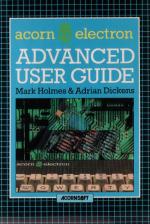Advanced User Guide
Advanced guide to a rapidly advancing Electron
The Acorn Electron Advanced User Guide is with us. And it's a good excuse to look at the progress the Electron has made over the last year and a half.
Firstly, although, like this book and like much software the soft support for the Electron has been derived from original BBC sources, the Electron hardware itself is progressing independently and according to what the market demands from it.
I'll mention hardware again later, and there's plenty about Electron plus disc drives in this issue. And soft support derived from the popularity and widely diverse uses of the BBC? Hardly a bad thing. A fact demonstrated admirably by the Advanced User Guide.
Mark Holmes and Adrian Dickens, two of the original authors behind the Advanced Guide for the BBC, have compiled a very attractive and useful programmers' guide. There are also some hints as to Acorn's intentions for the Electron.
The Guide
The original BBC edition of this book was a practical but rather unattractive product, spiral-bound and liable to suffer from being poured over by programmers greedy for information. The Electron version has been taken on by Adder publishing, has the Acornsoft logo and approval and goes into Acornsoft's own catalogue.
An initial comment from the heart urges readers to consider the Electron in its own right and not to worry about BBC comparisons. This is followed by a breakdown on the famous Acorn design philosophy which has taken such a bashing in the computer press recently. Acorn designed the Electron to be expandable so that it could face the naturally turbulent microcomputer market waters in the future with hardware add-ons. Indeed *all* the 6502 bus lines are available for expansion via the edge connector. However, the authors tell us, software has to be designed to use the operating system calls which enable hardware upgrades.
Those operating system calls are now explained, listed in their various forms with all the information you could possibly need about their operations, OSBYTE by OSBYTE, OSWORD on OSWORD. Get to know these routines and you get to know your machine, how it works and how to make it work for you through software.
Operating routines in the OS ROM are accessed via vectors (pointers) in RAM locations. These vectors are listed and explained and ways of intercepting them for our own programming purposes discussed and demonstrated. This takes us on to events and a whole chapter on interrupts. Interrupts from add-on devices are a complicated matter with the Electron running at various different colock speeds during its operation. A very interesting chapter best read before tackling the chapters on Electron hardware and implementing expansion hardware.
The other main part of the Advanced User Guide deals with implementing ROM software - and the Electron could do with it! The authors go into Service, Language and Serially accessed ROMs. The latter ROM filing system has hardly been utilised fully on the BBC. Acorn cartridges never took off and only recently have some companies like Viglen gone in for a cartridge-type slot. The Electron Plus 1 however is based around the two cartridge slots, for language, service and serially accessed programs.
All the information is here to allow developers convert their software to the cartridge format but apparently Acorn are having a great deal of trouble supplying the cartridges to software houses.
Further details on screen layout and a vast amount of information on memory usage will be invaluable to programmers. Especially fascinating is the description of the hardware, especially the fact that the flatpack ULA seems to do almost everything!
Some vital locations should help programmers with techniques such as vertical and horizontal scrolling. A full circuit diagram and comprehensive index complete the best thing since 3.5" discs for the Electron.
As with the BBC, programmers have taken their time to extract the full potential of the Electron but games are now emerging which indicate a change of gear. This book, and hopefully a number of firmware utilities, will make the programmer's art very much easier and increase the amount of good software available for the machine.
If you can, stick to the design philosophy because with Plus 1, 3 and 2 on the way, second processor capability and hints of RAM expansion, communications software, control modules and more, there's going to be a hefty market for compatible software.
Scores
BBC/Electron Version| Overall | 83% |


 1st June 1985
1st June 1985
